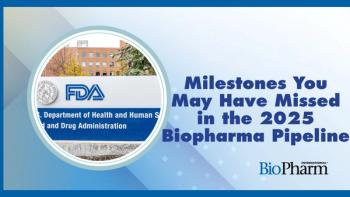
- BioPharm International-07-01-2003
- Volume 16
- Issue 7
Inside Washington: Debate Escalates Over Follow-On Biologics
FDA efforts to encourage generic drug approvals and to consolidate oversight for biotech therapies could open the door to biotech equivalents
Hoping to establish an affordable Medicare prescription drug benefit, Congress, the White House, and the Food and Drug Administration are taking steps to increase the use of less expensive generic therapies by reducing protracted patent disputes between brand-name and generics manufacturers.
Generic versions of major medications — such as those for diabetes and heart disease — accounted for 45% of all prescriptions in the United States last year, up 5% over 2001. The generic market is expected to rise even more as blockbuster treatments lose their patent protection, and as health plans, insurers, and large employers offer consumers financial incentives to accept generic therapies. These prescription drug payers, along with generics firms, are also looking for strategies to develop “follow-on” versions of the biologics slated to lose patent protection in the near future.
Currently, there are 350 biotech drug products and vaccines in clinical trials. By 2010, biologics are expected to create a $60 billion market. It may also be important to have multiple sources of important biologics to avoid product shortages, particularly in a national emergency. Consequently, both generics manufacturers and policy makers are looking for legal and technical strategies for developing therapeutically equivalent biologics. Although new legislation before Congress avoids addressing FDA policies to facilitate approval of therapeutically equivalent biotech therapies, generics makers will continue to press for clarification of these issues.
Battle over Biologics
Biotech companies claim that interferons, growth hormones, and proteins do not lend themselves to generic production because live cell cultures yield considerable variation among batches and require much more testing than conventional drugs. Generics makers acknowledge that biologics are more complex but believe that more sophisticated production and testing methods can address product quality concerns.
According to Janet Woodcock, director of FDA’s Center for Drug Evaluation and Research (CDER), agency policy on biotechnology equivalence is “evolving.” The consolidation of oversight for Center for Biologics Evaluation and Research (CBER) therapeutics in CDER provides an opportunity for “coherent policy development,” she says (see “CDER Shifts Personnel to Oversee Biotech Therapies,” below).
FDA will begin examining data requirements for generic biologics in coming months, Woodcock explains, noting that evaluation of equivalence for biotech products usually requires full chemistry, manufacturing, and controls (CMC) information — including comparative characterization data — for the listed drug and the follow-on product. That information is key to determining the need for preclinical safety tests, comparative pharmacokinetic studies, and possibly full comparative clinical studies. Experts on both sides agree that considerable analytical testing — and probably some preclinical and clinical studies — are needed to document the comparability of biotech products. But they also point to advances in bioinformatics, microarray, and pharmacogenomics technologies that yield more reliable testing of comparable therapies.
Hybrid Route
One controversial idea is for FDA to use the 505(b)(2) provision in the Hatch–Waxman Act to approve a biotech therapy that differs from the innovator product but relies on the innovator’s data. Manufacturers have used this hybrid approach only occasionally over the past 15 years to bring some drugs to market, but it is gaining attention as mature generics companies — and some biotechs — see it as a way to develop equivalent versions of complex therapies.
FDA issued a draft guidance for implementing the 505(b)(2) process in 1999 (
Generics makers also could seek to establish comparability protocols for follow-on therapies, as biotech manufacturers have done to manage their postapproval manufacturing changes. Since 1997, biotech companies have filed more than 100 comparability protocols that define how a company can document that the identity, strength, quality, purity, or potency of a product is not adversely affected by subsequent changes in manufacturing processes, facilities, quality control, or formulation. The key question is whether procedures originally designed to help innovator companies manage manufacturing changes can also be used by other manufacturers to document that their follow-on products meet quality standards.
FDA wants to encourage more use of comparability protocols and already has approved “comparable” versions of some biologics based on data documenting pharmaceutical equivalence. For now, though, FDA says it will consider these issues on a case-by-case basis. New technology may facilitate the development of therapeutically equivalent or interchangeable versions of biologics in the future — particularly for growth hormones, insulin, and monoclonal antibodies that can be fairly well characterized — but legislation probably is needed to establish a clear pathway for approval of such products.
Push for Legislation
Meanwhile, Congress is considering legislation to make conventional generic therapies more available to consumers by resolving some of the legal issues that have delayed generics marketing. Last year the Senate came close to approving a bill that made significant changes in the Hatch–Waxman Act. These changes to innovator patent protection generated strong opposition from brand-name manufacturers who blocked final enactment.
In June, Senators Judd Gregg (Rep–NH), chairman of the Senate Health, Education, Labor and Pensions Committee, and Charles Schumer (Dem–NY) led an effort to gain speedy Senate approval of new generic reform legislation. The compromise would prevent an innovator company from obtaining multiple 30-month stays on FDA approval of a generic product. Another provision would allow generics companies to file counter-claims if sued by a brand-name firm for patent infringement. A “use-or-lose” provision requires generics manufacturers to bring newly approved products to market in a timely manner or forfeit the 180-day exclusivity granted to the first generic applicant to gain FDA approval. And the bill clarifies that FDA may employ other scientifically valid methods to ensure bioequivalency of innovative dosage forms, such as topicals and inhalants.
The Senate moved in June to adopt the the generics legislation by adding the measure to Medicare reform legislation that establishes a prescription drug benefit for the elderly. This strategy would allow the estimated $60 billion in savings over 10 years from more generic prescribing to offset the high cost of Medicare pharmaceutical coverage.
Regulation and Resources
As the Senate bill emerged on Capitol Hill last month, FDA officials announced final publication of a new rule. Last October, President Bush signaled his administration’s strong support for prescribing generics by personally unveiling an FDA proposed regulation (
Federal Register
, Vol. 67, No. 260, Oct. 24, 2002, p.65418-65447). It aims to prevent excessive delays in FDA approval of new generics and clarifies which types of patents may or may not be listed in FDA’s
Orange Book
. Moreover, to reduce inappropriate listings, it requires a top executive of the innovator company to sign a more detailed declaration of patent validity. This rule also allows brand name companies only one 30-month stay but uses different legal language than the Senate bill. The legislators leave it up to FDA to oversee patent listings. However, further efforts may be needed to better mesh the FDA rule with new generic reform legislation.
FDA officials also are seeking increased resources for generic drug oversight to help the agency deal with the burgeoning volume of patent disputes. In testifying last spring on FDA’s upcoming budget for 2004, FDA Commissioner Mark McClellan backed a hefty $13 million boost in funding for FDA’s Office of Generic Drugs (OGD) to permit faster review of the nearly 400 generic drug applications the agency receives each year. Although pioneer manufacturers need adequate compensation provided by the patent system to encourage investment in drug innovation, McClellan emphasized the need to spur development of less costly bioequivalent therapies through regulatory and legislative change.
CDER Shifts Personnel to Oversee Biotech Therapies
The Center for Drug Evaluation and Research (CDER) has established an Office of Biotech Products (OBP) in its Office of Pharmaceutical Science (OPS). OBP will review and approve product quality data in the applications of therapies transferred to CDER from FDA’s Center for Biologics Evaluation and Research (CBER).
Of the more than 200 CBER staffers transferring to CDER, most moved into the new office by 1 July. In OBP, they will continue to conduct research and review the manufacturing sections of biologics licensing applications for new biotech therapies under the direction of OBP’s acting director, Yuan-yuan Chiu, formerly head of OPS’s Office of New Drug Chemistry (ONDC).
A smaller group of former CBER staffers will review clinical data as part of CDER’s Office of New Drugs, and several CBER compliance officials will join CDER’s Office of Compliance.
Moheb Nasr, director of the Division of Drug Analysis in CDER’s Office of Testing and Research, has moved to head ONDC temporarily; a prime task is to help implement a quality systems approach to chemistry reviews.
The consolidation plan becomes official 1 October 2003, the beginning of the federal government’s 2004 fiscal year.BPI
Articles in this issue
over 22 years ago
Inside the Outsourcing Relationshipover 22 years ago
Outsourcing Outlook: A Capacity for ExcessNewsletter
Stay at the forefront of biopharmaceutical innovation—subscribe to BioPharm International for expert insights on drug development, manufacturing, compliance, and more.





